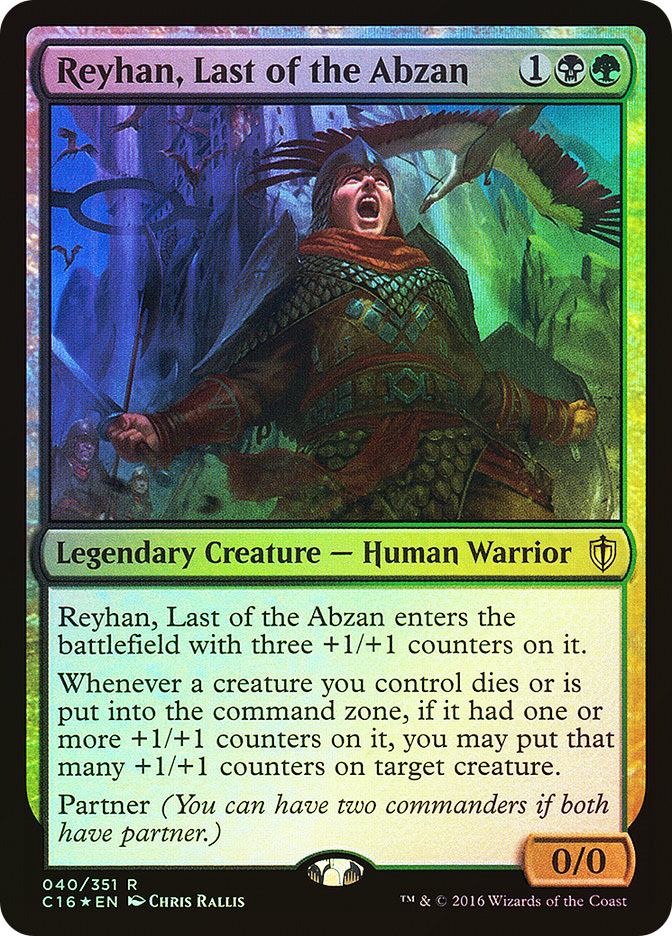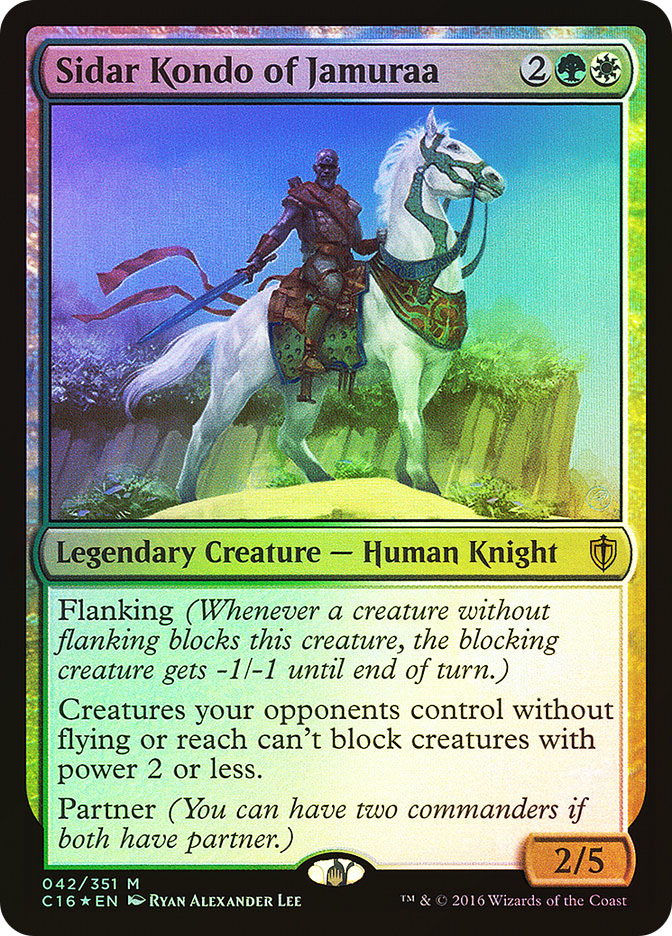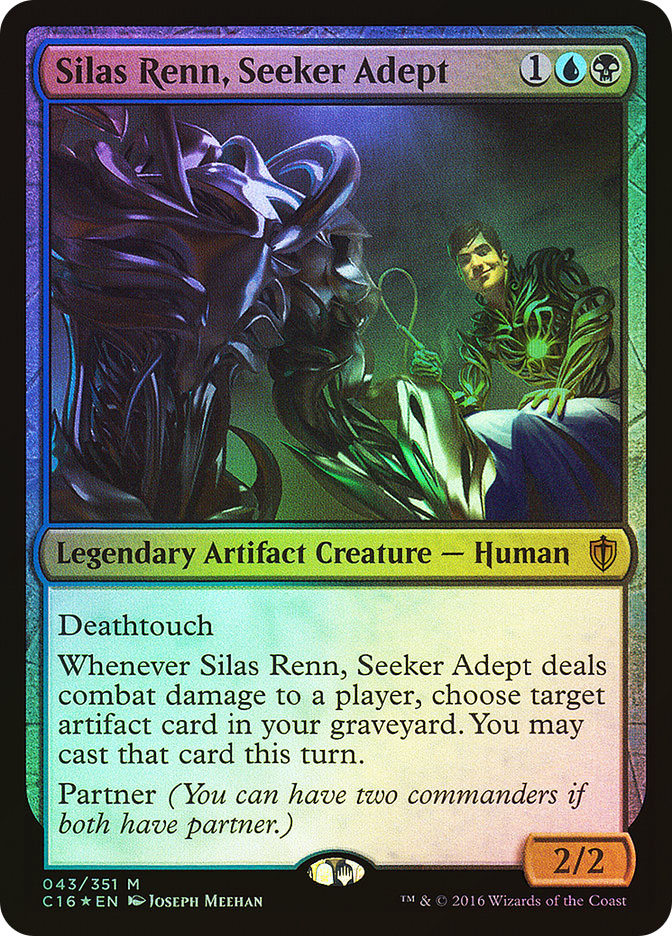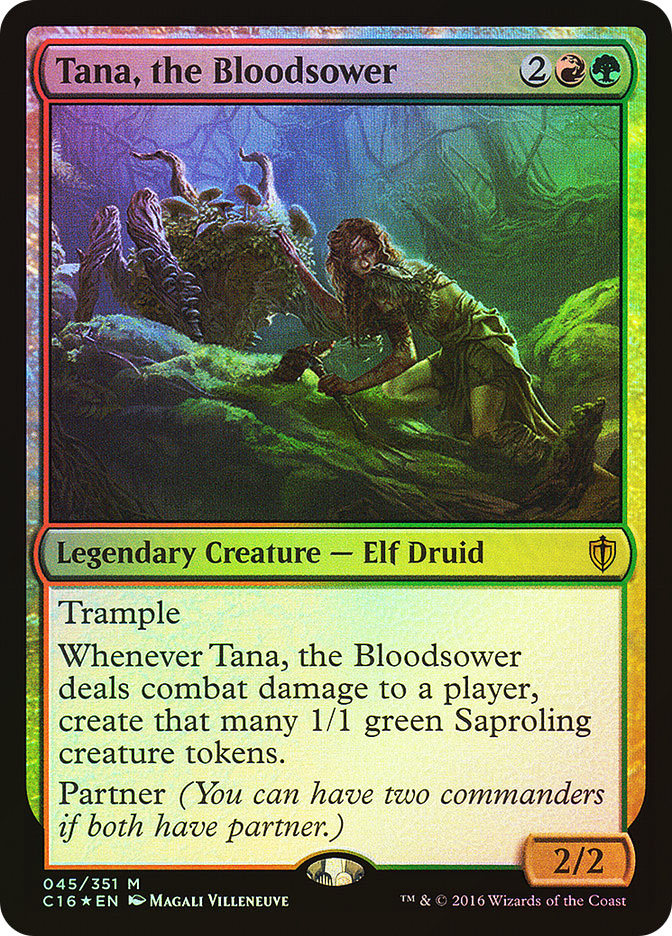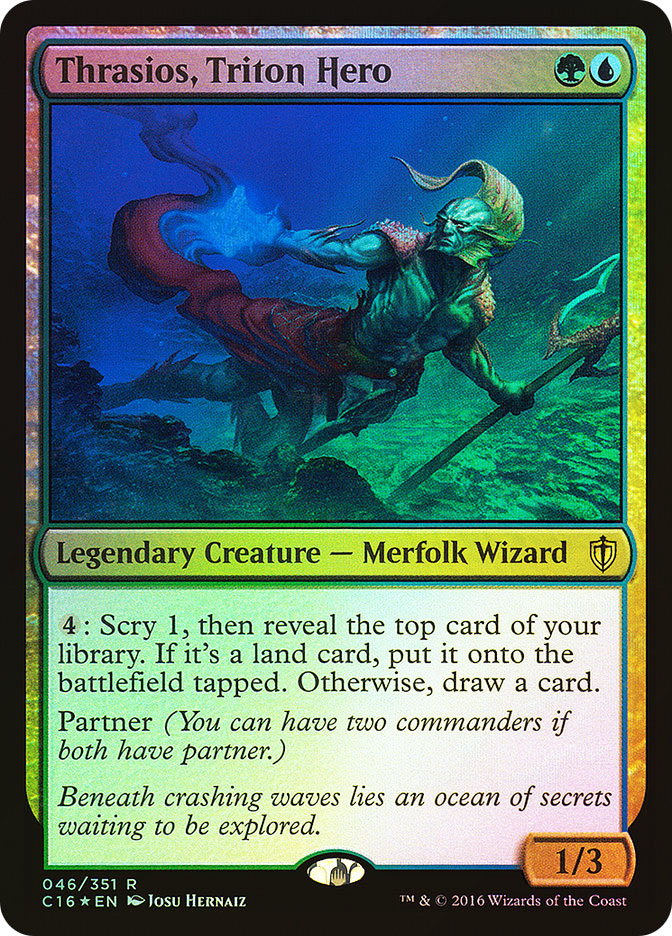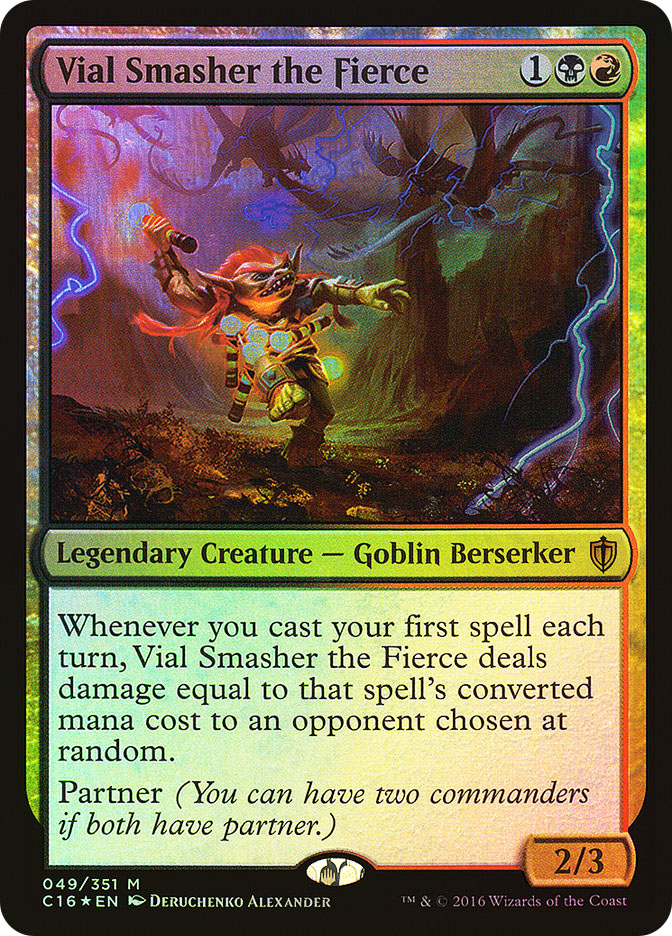Last week, I started a look into the Commander 2016 legendary creatures with partner, examining some of the strengths of each and who I might pair them up with. Let’s continue talking about those that we didn’t get to.
It’s obvious why the Abzan faded away: they lost all that life-giving white mana. Like other legendary creatures with partner, Reyhan seems like a very good role-player in any number of decks—like the one it’s already in, Breed Lethality, featuring Atraxa, Praetors’ Voice. It doesn’t even need to be in decks in which +1/+1 counters matter; Reyhan can start the chain reaction all alone, simply by having your creatures die. The hidden gem of the week for your “+1/+1 counters matter” deck is Armorcraft Judge.
Of course, in black and green, you have lots of great creatures and many wonderful ways to reanimate them. There’s a whole line to go down with Meren of Clan Nel Toth; Mazirek, Kraul Death Priest; and loads of reanimation. Speaking of which, someone needs to play Vengevine in this format. It’s not going to be the same kind of house that it was in Standard way back in the day, but it will get there in a deck which loves to sacrifice creatures and then have ways to cast them again. Karador, Ghost Chieftain is the obvious answer. Use Greater Good to sacrifice Vengeveine, cast something from your graveyard (maybe one of the creatures you discarded to Greater Good), and then cast something from your hand to get back Vengevine, ready for battle.
My first thought would be to build Reyhan with
The first thing to notice about Sidar Kondo of Jamuraa is that affects combats that you’re not involved in. No one’s creatures with power two or less are getting blocked by creatures without flying or reach (except by you). You can use a few saboteur creatures from Magic’s ancient days, like Floral Spuzzem and
The only real answer I see is to create a host of one- or two-power creatures and swing. Pairing up with Tana, the Bloodsower is definitely the right call here. Tana doesn’t get blocked, thereby creating more creatures. Each color in the Naya shard is capable of creating swarms of tiny tokens. Because you now have access to red mana, you can make bunches of Goblins. You were already in white, so Storm Herd is an option, along with a long-time favorite in the format, Decree of Justice.
Elves might be a path to explore, but you’ll have to avoid other creatures which might make them too large, like Dwynen, Gilt-Leaf Daen or Elvish Archdruid. If you’re committed to Elves, use Elvish Promenade, or if you’re not, play Saproling Symbiosis to effectively double up on your creatures. Then use Regal Force to refill your hand. Although you might normally encounter it as a commander in its own right, Rhys the Redeemed can get your creature count spun up in short order. Honestly, Sidar Kondo is the most difficult of all the partner commanders to do something decent with—but that’s part of the challenge we love about the format.
Ready for the perfect card to go with Silas Renn, Seeker Adept? It’s Alchemist’s Vial. For three mana every turn, you get to deal some combat damage and draw a card. It’s so janky that no one is going to (graveyard) hate you for running it. Silas Renn obviously loves artifacts which you sacrifice, whether that’s Aether Spellbomb, Burnished Hart, or Armillary Sphere. You might consider adding some self-mill to the deck in order to put juicier choices into the graveyard. Since we’re going with a “cast from the graveyard” theme, we have to add Havengul Lich. If we add Havengul Lich, we have to add some mill for our opponents as well; Mesmeric Orb and Mindcrank fit the bill. With so much cool stuff in graveyards, we need to then add Geth, Lord of the Vault and Rise of the Dark Realms. Unfortunately, all that milling irritates people and is kind of the natural direction Dimir-themed cards tend to go. I’d want a little more outside-the-box action (and to not get wrecked by Brooding Saurian).
I’m pairing up Silas Renn with
If you’re not content to use just your own artifacts, there’s always Magus of the Unseen, which is aptly named, since it’s really good and no one knows about it. We’ll have to play Sharding Sphinx because our artifact creatures are definitely dealing damage. The green which Reyhan gives us will let us play Fangren Marauder and loads of lifegain. Rounding out the deck is Disciple of the Vault for some extra life loss from all our artifacts moving in and out of the graveyard (and back in).
There are two straightforward elements we need to get mileage out of a Tana, the Bloodsower deck: getting Tana to deal damage and having something to do with all the tokens we create from it. Tana gives you a number of Saprolings equal to the damage she deals to a player; since she already has trample, so the primary issue will be getting bumping up her power. Kessig Wolf Run is in her colors, and sometimes only needs to be a threat in order to change how opponents approach combat.
While we won’t want to go completely Voltron, some decent Equipment is the right call here. All the popular ones, like Sword of Fire and Ice or Sword of Body and Mind certainly apply; the latter triggers and gives you an additional token in the form of a 2/2 Wolf. Looking to some of the less-used ones, Sword of Kaldra, while a little spendy, makes her huge and will take care of any indestructible blockers. For a bit of a mana investment, Kusari-Gama can help dealing with the remainder of the defending team, especially if you add Blight Sickle to give Tana wither. Once you start creating tokens, it’s just a matter of making them all dangerous, whether that’s Beastmaster Ascension, Overrun, or Overwhelming Stampede.
I’d pair Tana with Kydele, Chosen of Kruphix in order to add blue to the deck and go for a combat damage trigger theme, focusing on those triggers which draw cards. Access to blue offers us Bident of Thassa, Coastal Piracy, and Deepfathom Skulker, as well as the always-popular Edric, Spymaster of Trest. The Temur colors allow us to play Shaman of the Great Hunt, which continues the theme of making our creatures larger, plus allowing us to draw more cards. With all those cards drawn, we can activate Kydele, generating enough mana in order to cast and also equip the next Equipment. From there, it’s just dealer’s choice in figuring out which additional sub-themes you want to explore, such as doubling +1/+1 counters with Evolution Vat, Kalonian Hydra, and of course Doubling Season.
Thrasios is just good, solid value, which is why it was frequently in the running (or selected) as the partner for a number of other commanders. It suggests going back to an old favorite, landfall. You can add all of the “extra land drop” cards, such as Oracle of Mul Daya and Azusa, Lost but Seeking. Courser of Kruphix will gain additional life for you and allow you more land-playing flexibility. You of course have Coiling Oracle, the best two-drop ever. Just in U/G, you have quite a few landfall choices, such as the always-popular Avenger of Zendikar, Grazing Gladehart, Lotus Cobra, Oran-Rief Hydra, Rampaging Baloths, Roil Elemental, and Undergrowth Champion. If you want to be kind of wild, try Eternity Vessel. Just make sure no one is playing Thief of Blood (although it’s an optional ability, so you wouldn’t be forced to set your life to zero).
Nissa, Vastwood Seer and Titania, Protector of Argoth have strong landfall-like abilities which simply don’t have the keyword. Hedron Crab is a must-include if you’re going with any kind of Dredge strategy or adding black for some milling action. Black also gives you Ob Nixilis, the Fallen and Retreat to Hagra. Red is rather unexciting when it comes to landfall, save for Omnath, Locus of Rage and of course Valakut, the Molten Pinnacle. White is very strong with Admonition Angel, Emeria Angel, and Emeria Shepherd.
As I mentioned in Part One, it’d be difficult to resist the urge to pair Thrasios with Kydele, Chosen of Kruphix. It’s generally not my style, but I’d love to see if I could get some engine working with the two. It’d provide a little top of library control with the aforementioned Future Sight, Sensei’s Divining Top, and Scroll Rack, and then pay attention to not the land drops but the card draw. Perhaps I’d use Paradox Engine to get multiple uses per turn out of Kydele and other mana-producing creatures, especially those which untap other lands, like Juniper Order Druid, Krosan Restorer, Ley Druid, Stone-Seeder Hierophant, and Voyaging Satyr. The lands you want to untap are those which produce more than one mana, like Gaea’s Cradle or Nykthos, Shrine to Nyx.
There are enough cards which untap all your lands (or specific types) in one fashion or another, such as Turnabout, Reset, Bear Umbra, Rude Awakening, and Sword of Feast and Famine. Woodland Guidance seems like a nice little find, especially if you know what you’re clashing with. With all this mana, we can get numerous activations off Thrasios, drawing lots of cards and putting quite a few lands onto the battlefield. Then all we need is a kill condition. If we’d like to go the combat route, Maro, Overbeing of Myth, Sturmgeist, and Multani, Maro-Sorcerer would be arbitrarily large. Psychosis Crawler might kill with combat damage or simply from the card draw, especially if you add Myojin of Seeing Winds. Thrasios and Kydele together becomes an engine with which you can run the race any way you’d like.
Tymna needs combat damage to be of use. She doesn’t need to do the damage, but the more opponents you hit, the more cards you draw. This means we either have to make it so that we have so many creatures that we’ll always damage everyone or have our creatures be some kind of unblockable (meaning “actually can’t be blocked” or else the opponents’ creatures are tapped). I’m fond of the latter idea, with white providing some of the tapping and black offering up some creatures which are harder to block. Authority of the Consuls makes other players’ creatures enter the battlefield tapped and mitigates some of the life loss from Tymna. Blind Obedience does that even better. White also has the best creatures with vigilance, so you might consider Meekstone and Crackdown to keep creatures out of the way. I’m also a fan of Urborg, Tomb of Yawgmoth and Filth. Add Crusading Knight for more hilarity.
I’m going to pair Tymna with Silas Renn, Seeker Adept for maximum combat damage trigger tomfoolery. There are enough control elements in the Esper colors to make sure our creatures always get through. In addition to the white cards I’ve already mentioned, blue adds plenty of tappers, like Frost Titan and Opposition. The card I want to keep using and re-casting is Tainted Sigil. Usually, you’ll want to wait for a big damage hit to activate it. With Silas Renn, we can just cast it every turn, which will also help with the life we lose from Tymna. It also recovers life lost from Hatred. That’s some high synergy!
Vial Smasher the Fierce is pretty simple: cast a spell every turn, deal some damage. We’ll want a healthy dose of instants to be able to cast on other player’s turns—or we could just go with some creatures that have flash. Bogardan Hellkite and Dualcaster Mage are nice options. Obviously, we could just jam Vedalken Orrery into the deck and parse out our spells one turn at a time. Some big X spells, like Bonfire of the Damned or Comet Storm, would be sweet if we could figure out the mana generation issue. Maybe that Vedalken Orrery to go with Braid of Fire would be okay after all.
You’re going to think me silly for focusing on just two cards, but I’m going to pair Vial Smasher the Fierce with Ishai, Ojutai Dragonspeaker because it gives us access to both blue and white. From blue, we get Mind’s Dilation, which casts the spell—so when they cast their first spell of the turn, you also get to cast your first spell, triggering Vial Smasher. From white, we get Soulfire Grand Master, which gives lifelink to instant and sorcery spells that we control—to include those we might get off of Mind’s Dilation. Now our big X spells deal damage (maybe twice) and gain life as well. I think I’m onto one of those Rube Goldberg machine-type builds here.
For space purposes, this week’s Deck Without Comment will be the one of these pairings I’m most likely to build.
Creatures (32)
- 1 Solemn Simulacrum
- 1 Sun Quan, Lord of Wu
- 1 Wood Elves
- 1 Yavimaya Elder
- 1 Duplicant
- 1 Coiling Oracle
- 1 Farhaven Elf
- 1 Oracle of Mul Daya
- 1 Avenger of Zendikar
- 1 Kozilek, Butcher of Truth
- 1 Rapacious One
- 1 Ulamog, the Infinite Gyre
- 1 Psychosis Crawler
- 1 Phyrexian Metamorph
- 1 Phyrexian Ingester
- 1 Edric, Spymaster of Trest
- 1 Nin, the Pain Artist
- 1 Rage Thrower
- 1 Maelstrom Wanderer
- 1 Rubblehulk
- 1 Thassa, God of the Sea
- 1 Chasm Skulker
- 1 Jalira, Master Polymorphist
- 1 Reclamation Sage
- 1 Shaman of the Great Hunt
- 1 Oblivion Sower
- 1 Ulamog, the Ceaseless Hunger
- 1 Kozilek, the Great Distortion
- 1 Deepfathom Skulker
- 1 Rashmi, Eternities Crafter
- 1 Padeem, Consul of Innovation
- 1 Thrasios, Triton Hero
Planeswalkers (2)
Lands (37)
- 9 Forest
- 1 Wasteland
- 1 Mountain
- 7 Island
- 1 Volcanic Island
- 1 Tropical Island
- 1 Taiga
- 1 Temple of the False God
- 1 Yavimaya Hollow
- 1 Maze of Ith
- 1 Dust Bowl
- 1 Steam Vents
- 1 Stomping Ground
- 1 Breeding Pool
- 1 Reliquary Tower
- 1 Rootbound Crag
- 1 Command Tower
- 1 Hinterland Harbor
- 1 Sulfur Falls
- 1 Kessig Wolf Run
- 1 Alchemist's Refuge
- 1 Nykthos, Shrine to Nyx
- 1 Frontier Bivouac
Spells (27)
- 1 Sol Ring
- 1 Kodama's Reach
- 1 Artifact Mutation
- 1 Sword of Light and Shadow
- 1 Sword of Fire and Ice
- 1 Turnabout
- 1 Vedalken Orrery
- 1 Proteus Staff
- 1 Coastal Piracy
- 1 Aggravated Assault
- 1 Greater Good
- 1 Skyshroud Claim
- 1 Phyrexian Altar
- 1 Cryptic Command
- 1 Thousand-Year Elixir
- 1 Beastmaster Ascension
- 1 Eldrazi Monument
- 1 Basilisk Collar
- 1 Bear Umbra
- 1 Cultivate
- 1 Sword of Body and Mind
- 1 Sword of Feast and Famine
- 1 Warstorm Surge
- 1 Cyclonic Rift
- 1 Glaring Spotlight
- 1 Expropriate
- 1 Paradox Engine

Check out our comprehensive Deck List Database for lists of all my decks:
SIGNATURE DECKS
Purple Hippos and Maro Sorcerers; Kresh Into the Red Zone; Halloween with Karador; Dreaming of Intet; You Did This to Yourself;
THE CHROMATIC PROJECT
Mono-Color
Heliod, God of Enchantments; Thassa, God of Merfolk; Erebos and the Halls Of The Dead; Forge of Purphoros; Nylea of the Woodland Realm; Karn Evil No. 9
Guilds
Lavinia Blinks; Obzedat, Ghost Killer; Aurelia Goes to War; Trostani and Her Angels; Lazav, Shapeshifting Mastermind; Zegana and a Dice Bag; Rakdos Reimagined; Glissa, Glissa; Ruric Thar and His Beastly Fight Club; You Take the Crown, I’ll Take Leovold; Gisa and Geralf Together Forever;
Shards and Wedges
Adun’s Toolbox; Animar’s Swarm; Karrthus, Who Rains Fire From The Sky; Demons of Kaalia; Merieke’s Esper Dragons; Nath of the Value Leaf; Rith’s Tokens; The Mill-Meoplasm; The Altar of Thraximundar; The Threat of Yasova; Zombies of Tresserhorn
Four Color
Yidris: Money for Nothing, Cards for Free; Saskia Unyielding;
Five-Color
THE DO-OVER PROJECT
Animar Do-Over; Karador Do-Over; Karador Version 3; Karrthus Do-Over; Steam-Powered Merieke Do-Over; Mimeoplasm Do-Over; Phelddagrif Do-Over; Rith Do-Over; Ruhan Do-Over
If you’d like to follow the adventures of my Monday Night RPG group (in a campaign that’s been alive since 1987) which is just beginning the saga The Lost Cities of Nevinor, ask for an invitation to the Facebook group “Sheldon Menery’s Monday Night Gamers.”


